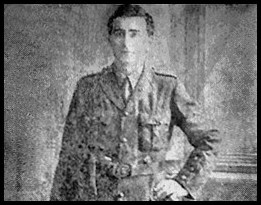|
The Rescue of Donnachada MacNiallghuis (Irish War of Independence - First Cork Brigade) |
A native of The wounded Head Constable was
in danger of death, and if he died the fate of MacNiallghuis was certain, unless he could be rescued.
When
his comrades came to consider how the rescue attempt
was to be made they were faced with a dilemma. After
his arrest MacNiallghuis had been taken to Cork Jail, together with Denis Kelleher who had gone to his assistance at the time of the raid. Practically nothing was
known of the circumstances inside the prison, except that
there was an armed military guard always on duty. The
Volunteers had no contact with any person in
or employed at Cork Jail. On the night of November 4, a hastily summoned
meeting of the available members of the Brigade Council was held at the
house of the acting Brigade Commandant, Sean
O'Hegarty, who was in charge of the operation. Within six days arrangements
for the rescue had been drawn up.
Cork Jail - the scene of the escape. The prison was surrounded by a high wall, standing
clear of the buildings within. The entrance
was closed on the outside by a pair of heavy iron-bound
doors, in one of which was a small wicket. The outer doors gave
access to a small space closed on the inner side by a pair of heavy wrought-iron gates, which extended the full height
of the archway. Opening off the space
between the two gates, and to the left was the visitors' waiting room, in which a warder was always on duty. Untried prisoners were allowed one visit of ten minutes' duration each day between 10 and Sean Scanlan visited MacNiallghuis on the Wednesday,
and whilst shaking hands across the barrier managed to pass him a small
note outlining the rescue plans. On the afternoon of Monday, November
11 at Meanwhile the remainder of the rescue party took up
their allotted positions in the neighbourhood of the prison, watching carefully
for the time when, in accordance with their
instructions, they should hold up all persons approaching
the prison. The last pair had been five minutes inside the prison when the
outside party came into action. Paddy Varien cut the telephone wires
leading into the prison and the isolation of the building was completed. Inside the prison a warder came down from the main buildings to take Joe Murphy and Martin Donovan to the visiting cell. MacNiallghuis was brought in on the other side of the cell and locked in. The visiting cell had a double barrier between the prisoner and his
visitors, and between the two barriers the warder walked up and down during the
interviews. The visitors spoke to the prisoner
across the barriers. After chatting with him for a few minutes they bade him
goodbye. The warder inserted the key in the lock to let
them out and in a flash they were upon him; he was down and unconscious without more than
a groan. The key turned in the lock; the door opened. Immediately MacNiallghuis was
over the barrier into the visitors side of the cell and through the gate into the prison grounds. A revolver was passed to him,
and all three started to walk at an easy pace towards the main gate, by
the path inside the prison wall. Once past
the sentry all three ran towards the main gate. In the waiting room below the four volunteers waited until five minutes had elapsed after the first pair were taken to the
visiting cell. Then they suddenly closed on the warder, felled him and
disconnected the telephone. They tied the
warder securely and took his keys. Through
to the outside filed the whole party, locking
the gates behind them. With all the prison gates locked nobody could get in or
out. The rescue party had all the keys—and
MacNiallghuis was again outside the prison walls.
Elaborate arrangements had been made for
getting the rescued man safely away. However,
it had not been possible to convey to MacNiallghuis the arrangements made
for his getaway from the vicinity of the
jail. Amidst the confusion a volunteer had
left a bicycle standing outside the prison gate. MacNiallghuis asked him if the bicycle was for him. The man was
uncertain, as he was not one of those
detailed to cover the getaway. MacNiallghuis mounted the bicycle and rode away in
the direction of For several hours he was completely lost; he had eluded not alone his captors but also his rescuers! He eventually turned back and cycled near to the prison entrance again only to find that everybody had left. He eventually met with two volunteers, Dominic Sullivan and Florrie O'Donoghue and, travelling on foot and avoiding the roads as much as possible, arrived next morning at O'Mahony's, Berrings. There men from the Sixth Battalion took over his protection. Head Constable Clarke, although seriously wounded, eventually made a good recovery. |
|
|


